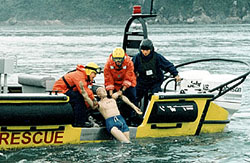



















| |
 Marine Police launch creates rough sea conditions for joint rescue exercise  |
OFFICERS of the Small Craft Training Section of
Marine Police Training School and the Fire Services Department's Airport Fire Contingent (including
an assistant divisional commander responsible for co-ordination between Government departments)
recently underwent a joint speedboat rescue training exercise to enhance co-operation between the
two disciplined services when responding to maritime emergencies if and when they occur within a
five-kilometre radius at either end of the new airport's runways.
The first two days of the five-day training exercise involved basic speedboat manoeuvring skills and safety measures on craft similar to the Boston Whaler speedboats used by Marine Police for anti-smuggling activities. Man overboard training on day three saw participants learning the teamwork and skills required in rescuing people from the sea off Joss House Bay with lifelike dummies used as victims. |
|
"There's usually a team of four officers who each have an individual role during a water rescue," said SIP Leung Kwok-sun of the Marine Police Training School. "The rescue boat's commander/lookout who stands at the bow is responsible for locating drifters (accident victims in the sea), with the coxswain steering the boat to the drifters in accordance with the lookout's instructions," explained SIP Leung. "Then the rescue boat comes to a correct position alongside the victim, the lifesaver uses a boat hook to secure the drifter, then together with the lookout, they grasp the drifter under the arms, make sure he or she is facing away from the boat, then pull the person from the sea safely up into the boat via the cut door position. The fourth officer on the boat, called the reserve, plays a significant role as the second lookout and extra hand, especially during a rescue of a group of drifters in high seas where the craft may be tossed and turned and the unexpected can happen." Indeed, because rescuers need to be prepared for accidents that occur in all types of weather including high seas, pouring rain and storms, rough sea handling for man overboard constituted an important part of the joint speedboat rescue training exercise. To this end, Marine Police Training Launch PL 82 was deployed to artificially create rough sea conditions, and in the latter days of the exercise the trainees practised towage and rough sea handling exercises for man overboard (single and group drifters) in the usually rough and high seas surrounding Ninepin Group Islands and in Clear Water Bay. "Being able to control the performance of a speedboat in rough seas is crucial to rescuing a person in waters," said SIP Leung. "Under those conditions it is extremely difficult to safely approach a drifter, then at full stop to pull them from the sea without injury to either the victim or rescuers. Which is why this training is so important. It is also very useful in terms of manpower deployment and resource allocation for joint rescue action between Government departments." | |

